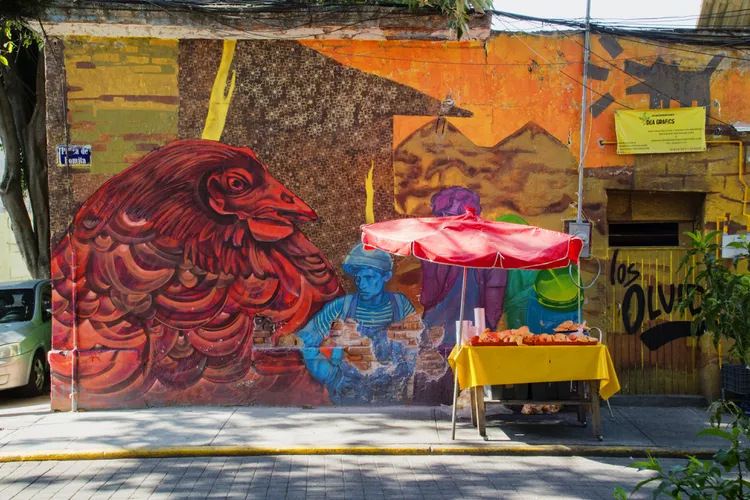Explore Mexico City: Neighborhood Highlights
As one of the biggest cities in the world, Mexico City can be difficult to navigate. Break it down into neighborhoods, though, and you’ll find it’s much easier to get around. Here are some of the most interesting and intriguing areas of Mexico City to visit and explore. If you’re new in town, a ride on the Turibus can provide a good overview of the city and where these neighborhoods are located.
Centro Historico

Until the 1900s, what is now the historical center of Mexico City was the city itself, while the surrounding areas were considered outskirts. The Aztec heart of Mexico City still beats here; visit the ruins of the main Aztec temple, Templo Mayor, beside the magnificent cathedral. Wander the Zócalo and admire murals by Diego Rivera inside the government palace. Walking through the streets, you’ll come across a variety of palaces and churches dating back to the colonial period as well as impressive constructions like the grand Palacio de Bellas Artes. A perfect way to take in the view from above is by going to the top of the Torre Latinoamericana.
Zona Rosa

The Zona Rosa, or “Pink Zone,” is part of the larger Colonia Juarez and was originally a residential area for wealthy families. In the 1950s and 60s, it thrived with a multitude of upscale hotels and restaurants. However, from the 1970s, it faced decline but has witnessed a revival in recent years. This area is the heart of Mexico City’s gay community and features a vibrant nightlife; consider staying in one of the nearby hotels if you’re planning to enjoy the energetic atmosphere. The iconic Angel of Independence stands prominently on Paseo de la Reforma, marking this area’s central landmark.
Colonia Roma

Colonia Roma is known for its bohemian atmosphere and charming streets, which retain their character even as the area gentrifies. Stroll along Álvaro Obregón, the neighborhood’s main street, to appreciate its Art Nouveau architecture. A standout building in Colonia Roma is the Centro Cultural Casa Lamm, hailing from the early 20th century, now serving as a cultural center, bookstore, and restaurant. While this area may feel rougher around the edges compared to nearby Condesa, it is home to upscale spots such as Contramar, celebrated for its seafood, and Máximo Bistrot, a low-key French bistro offering top-quality dishes made with local ingredients.
La Condesa

One of the trendier areas in Mexico City, La Condesa has roots in land that originally belonged to María Magdalena Dávalos de Bracamontes y Orozco, the Countess of Miravalle. After the Mexican Revolution, this land was subdivided for luxurious homes for the affluent. Today, La Condesa features beautiful Art Deco homes and leafy parks alongside boutique shops, bars, and restaurants. Parque Mexico is a defining landmark in this neighborhood, once a horse race track of the Mexican Jockey Club and now designed with elements of a European garden, complete with ponds and paths suitable for leisurely strolls. The park also hosts various cultural events and gatherings for the community.
Polanco

Polanco is known as Mexico City’s most affluent neighborhood, famous for its designer shops and upscale restaurants, many located on the elegant Avenida Masaryk, named after a Czech president. This neighborhood boasts a vibrant cultural mix, including significant Jewish and Lebanese communities. Visitors seeking gourmet dining experiences will flock to Polanco to taste Pujol’s renowned dishes. Moreover, tourists wishing to indulge in luxury accommodations can choose between the W Mexico City and the Intercontinental Presidente available in this vicinity.
Chapultepec

Chapultepec Park attracts locals throughout the week, but weekends remain especially vibrant as families gather to enjoy its attractions. The park is divided into three sections, featuring restaurants, gardens, amusement parks, a zoo, and an artificial lake with pedal boats available for rent. Notable within Chapultepec are several museums, including the esteemed National Anthropology Museum. The majestic Paseo de la Reforma connects the park’s castle to the historical center, aligning with various sculptures and monuments enhancing the walk.
Santa Fe

Santa Fe is a modern marvel located on Mexico City’s western edge, characterized by its impressive skyscrapers and contemporary infrastructure. A highlight of this area is Plaza Santa Fe, recognized as one of the largest and most luxurious shopping malls, coupled with a prominent convention center, Expo Santa Fe.
Coyoacán

This historic area, meaning “place of the Coyotes” in Nahuatl, was inhabited in ancient times. The two central plazas, Jardín Centenario and Plaza Hidalgo, exude charm filled with families strolling and are lined with quaint cafes, bookstores, and cantinas. Coyoacán is famed as the neighborhood where Frida Kahlo lived, and her home, La Casa Azul, now serves as a museum. Additionally, you can visit the residence where Leon Trotsky spent his final days, located nearby.
San Ángel

Once an independent village, San Ángel is now a vibrant hub for artists and artisans. Visiting on Saturdays offers the best experience, as the Bazar del Sábado fills the central square, Plaza San Jacinto, with stalls selling an array of paintings, sculptures, and handicrafts. Don’t forget to stop by the Museo Casa del Risco, which offers free admission on Saturdays to see beautiful tile fountains and paintings that reflect Mexican baroque and medieval European art. Indulge in a leisurely lunch at San Ángel Inn and make sure to visit the Diego Rivera and Frida Kahlo House Studio Museum for an enriching cultural experience.
Xochimilco

The canals of Xochimilco showcase a post-Aztec agricultural innovation known as chinampas, enabling the Aztecs to cultivate crops in a swampy landscape. Today, tourists can experience these canals by riding on flat-bottomed boats called trajineras, enjoying mariachi music and traditional cuisine while floating through this tranquil area south of Mexico City. Additionally, the Dolores Olmedo museum in Xochimilco features a vast collection of modern art, including notable works by Frida Kahlo and Diego Rivera.





